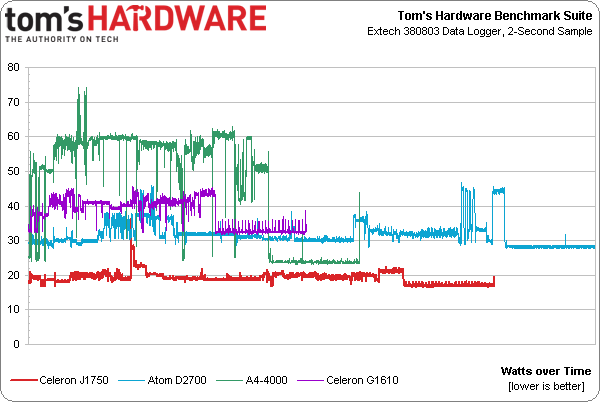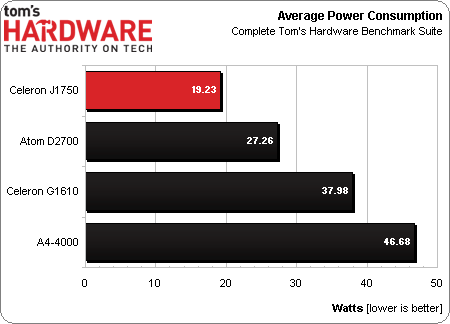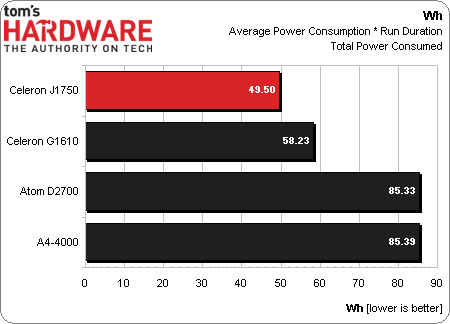Bay Trail On The Desktop: Celeron J1750 Gets Benchmarked
Last week, Intel rolled out its Bay Trail SoCs based on the Silvermont architecture. The company focused most intently on its tablet-oriented Atom models. However, we got our hands on a Celeron J1750, soldered onto a motherboard, for desktop testing.
Results: Power And Efficiency
We're going to buck convention today and start with a look at power consumption over time. I can't help it; after slogging through several pages of unexciting benchmark results in Intel Core i7-4960X Review: Ivy Bridge-E, Benchmarked, only to discover that efficiency was ironically the most interesting characteristic of Intel's new flagship, I'm really curious as to how Bay Trail registers, even if it means spoiling some of the performance story.
The red line is Intel's 10 W Celeron J1750, and wow, check out that power consumption through our suite. We can tell by the length of the line that the new Celeron isn't the fastest option in our selection of processors. However, it does give us a taste of what's to come compared to Atom D2700 (with discrete graphics) and AMD's A4-4000.
Averaging power consumption across the entire run distills the line graph into something simpler. We get confirmation that the Celeron J1750 uses very little power. The entire platform, including storage and memory, averages less than 20 W. Zotac's Atom D2700-based platform is rated for the same 10 W, yet averages notably higher consumption. This is because it's complemented by a GeForce GT 520 discrete GPU, though. Can't blame this one on the host processor. And as a result, we can't generalize about Bay Trail's efficiency versus Cedarview.
The Ivy Bridge-based Celeron G1610 steps average draw up an additional 10 W and is followed up by the 32 nm A4-4000 almost 9 W higher than that.
What this figure fails to tell us is how efficiently each platform handles our benchmark suite. For that, we multiply the average power by the time it takes to finish the benchmarks, which are all the performance-sensitive, faster-is-better type.
Again, Intel is doing amazing things with 22 nm manufacturing and its latest architectures. Celeron J1750, based on Silvermont, is more efficient than even the Ivy Bridge-based Celeron G1610, which smoked through our benchmark suite, but used more power to do so.
The Atom D2700, dragged down on the power side by a GeForce GT 520 graphics chip that doesn't encounter much 3D work in the pared-back list of tests we're using, fares poorly. It still turns out .06 Wh more efficient than the A4-4000, however.
Get Tom's Hardware's best news and in-depth reviews, straight to your inbox.
So, even before we break into the performance numbers, we have to be excited about Bay Trail's prospects in the tablet space, where we can be relatively sure that this is a faster, more efficient design than what came before. Remember also that we're looking at the Celeron J1750, the lowest-end desktop model. Intel has two other 10 W SKUs with four cores each that'll cut through threaded applications with more alacrity than the dual-core SoC on our test bench.
Current page: Results: Power And Efficiency
Prev Page Bay Trail's Performance On The Desktop: Benchmarking Celeron J1750 Next Page Results: Synthetics And 3D-
SteelCity1981 only 2mb of l2 cache for 4 cores. talk about starving 4 cores with 2mb of l2 cache.Reply -
DjEaZy ... interesting is the modular core thingy.. it ir like the FX module from AMD... 2 cores on joined L2 cache? Hmm... and GPU on the silicon... it seams, intel waits till the software is there...Reply -
stickmansam Reply11551610 said:... interesting is the modular core thingy.. it ir like the FX module from AMD... 2 cores on joined L2 cache? Hmm... and GPU on the silicon... it seams, intel waits till the software is there...
Shared L2 cache exists on Intel's side during the Core 2 era with two or more cores sharing the L2 cache, similar to how L3 cache is shared now except there is an additional private L2 cache. Basically, with Nehalem, Intel moved the shared cache a level lower to L3 and put in a new private cache (L2). GPU on the same die/chip has been on Intel's side too for quite a while as well....
11551497 said:only 2mb of l2 cache for 4 cores. talk about starving 4 cores with 2mb of l2 cache.
The i5s have actually less cache than the Q9x50's so cache size isn't everything. Their ipc is still lower than the Athlon IIx4's which have similar amounts of cache are not that bottle necked (compared to Phenom II's, maybe 20% slower?). Cache implementation also matters and the shared L2 should be better than the piecemeal Athlon II L2, provided the cores don't thrash each other.
Bay Trail is a quite interesting chip with good enough performance to pretty much beat out most ARM chips in tablets yet provide comparable power efficiency and graphics. The price is not too high either, with the top end chip ~$40, making it at least somewhat competitive with ARM. The ability to run Android/Linux/Windows 8 means that OEM's can build one product to sell to different markets and save on production line costs. It also lets them adjust the OS to meet market demand on the go potential (ship non selling OS version back to factory and load OS that sells better and send it back out). ASUS seems to have something like that going on with the T100 having buttons half way between Windows and Android and no Windows branding.
This all makes me want to grab a Bay Trail and run both Android and Windows on it, have Windows when I use it connected to a screen for desktop and run desktop apps and then Android on the go so I get the larger app store (Windows if I am lazy). -
vipervoid1 There is Kabini in the review ??Reply
Why compare Richland with this ??
Isn't Kabini is the one to compare ?? -
runswindows95 Then again, the thing to keep in mind these CPU's aren't gaming / workstation CPU's. These CPU's will quite honestly work for the majority of PC owners, who mainly do social media and Youtube. A quad-core that only uses 10W intrigues me a lot since I don't game, but do a lot of heavy word processing.Reply -
ojas Reply
Agreed.11551718 said:There is Kabini in the review ??
Why compare Richland with this ??
Isn't Kabini is the one to compare ??
Though, Tech Report and AnandTech have previewed the Z3770 and put it up against mobile chips and Kabini.
(hint: the 4w Z3770 matches a 15w A4-5000 Kabini and soundly thrashes ARM in CPU performance)
http://techreport.com/review/25329/intel-atom-z3000-bay-trail-soc-revealed
http://www.anandtech.com/show/7314/intel-baytrail-preview-intel-atom-z3770-tested -
de5_Roy i sorely missed a kabini setup in the benches and efficiency tests. i woulda liked to see both bay trail and kabini socs run 1080p and 1600p gaming (tablet oriented).Reply
a few nitpicks:
in the test hardware chart - a4 4000 doesn't have L3 cache. afaik, neither does baytrail (1MB shared L2).
in the bga 65w skus vs bga 10 skus table, the core i- cpus clockrates are base clockrate, turbo is missing while baytrail socs' burst clockrate is reported while base clockrate is absent. -
Wisecracker Reply11552261 said:
Agreed.11551718 said:There is Kabini in the review ??
Why compare Richland with this ??
Isn't Kabini is the one to compare ??
Though, Tech Report and AnandTech have previewed the Z3770 and put it up against mobile chips and Kabini.
(hint: the 4w Z3770 matches a 15w A4-5000 Kabini and soundly thrashes ARM in CPU performance)
http://techreport.com/review/25329/intel-atom-z3000-bay-trail-soc-revealed
http://www.anandtech.com/show/7314/intel-baytrail-preview-intel-atom-z3770-tested
Not according to Tom's ...
Power consumption looks great ... especially compared to a 65w Richland desktop (WTF, THG?) ... but the A4-5000 remains quite formidable in efficiency according to Tom's own testing
Graphics performance compared to the AMD SoCs must blow, or it would have been hyped to the max. I suspect this means Bay Trail will be Temash'd (or, Kabini'd).
-
CaedenV Looks like these new Atom based Celerons and Pentiums are what I want to look for in my little always-on server build I am prepping for. Extremely low power, enough performance to run a gigabit NAS, and hopefully some passive or other extremely quiet cooling solutions. I just hope that the motherboards offer some RAID options to work with in FreeNAS and the price is appropriately cheap.Reply



